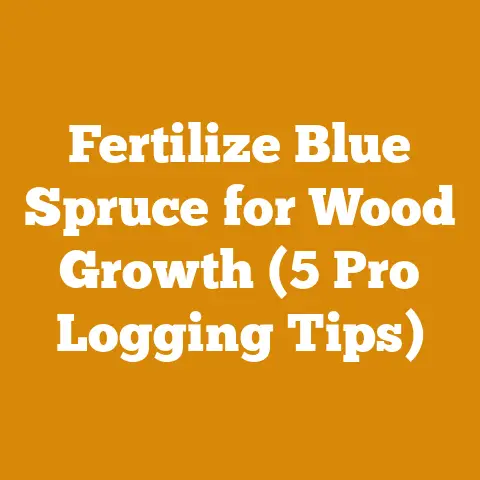Pine Tree Fungicide Guide (5 Pro Tips for Healthy Wood)
Did you know that fungal diseases cause an estimated $3 billion in timber losses annually worldwide?
That’s a staggering figure, and it highlights the importance of proactive pine tree care.
As someone who’s spent decades felling trees, milling lumber, and preparing firewood, I’ve seen firsthand the devastation that unchecked fungal infections can wreak on pine trees and the wood they produce.
I’ve learned through both successes and costly mistakes that understanding and implementing effective fungicide strategies is absolutely crucial for maintaining healthy wood.
This guide shares my hard-earned knowledge, offering practical tips to protect your pine trees and ensure high-quality timber for years to come.
Pine Tree Fungicide Guide: 5 Pro Tips for Healthy Wood
Pine trees, prized for their rapid growth and versatile wood, are unfortunately susceptible to a variety of fungal diseases.
These diseases can weaken trees, reduce timber quality, and even lead to mortality.
Protecting your pine trees with a well-planned fungicide program is an investment in the long-term health and value of your forest or woodlot.
1. Accurate Identification: Know Your Enemy
Before reaching for the fungicide, it’s essential to accurately identify the specific fungal disease affecting your pine trees.
Misdiagnosis can lead to ineffective treatments and wasted resources.
Common Pine Tree Fungal Diseases:
- Annosum Root Rot (Heterobasidion annosum): This is probably the most destructive fungal disease in pine.
It affects the roots and lower trunk, leading to decay, windthrow, and eventual death.
Look for conks (fungal fruiting bodies) near the base of the tree or on stumps.
These are often bracket-shaped and brown on top with a white underside. - Fusiform Rust (Cronartium quercuum f.
sp.
fusiforme): Primarily affects loblolly and slash pines in the southeastern United States.
Causes galls (swellings) on branches and stems.
These galls can weaken trees and make them susceptible to breakage. - Diplodia Tip Blight (Sphaeropsis sapinea): Attacks the tips of branches, causing browning and dieback.
Often affects stressed trees, particularly those suffering from drought or insect infestations. - Pitch Canker (Fusarium circinatum): Causes resinous cankers on branches and stems.
Can girdle and kill trees, especially young ones. - Brown Spot Needle Blight (Lecanosticta acicola): Causes brown spots on needles, leading to premature needle drop.
Primarily affects longleaf pine seedlings.
- Annosum Root Rot (Heterobasidion annosum): This is probably the most destructive fungal disease in pine.
Diagnostic Techniques:
- Visual Inspection: Carefully examine your trees for signs of fungal infection, such as discolored needles, galls, cankers, or fungal fruiting bodies.
Use a magnifying glass to get a closer look at suspicious lesions. - Sample Collection: Collect samples of affected tissues (needles, bark, wood) and send them to a plant diagnostic laboratory for identification.
Your local agricultural extension office can provide information on laboratories in your area. - Professional Consultation: If you’re unsure about the diagnosis, consult with a certified arborist or forest pathologist.
They can provide expert advice and recommend appropriate treatment strategies.
- Visual Inspection: Carefully examine your trees for signs of fungal infection, such as discolored needles, galls, cankers, or fungal fruiting bodies.
My Personal Experience: I once misdiagnosed Diplodia tip blight as insect damage on a stand of young Scotch pines.
I wasted valuable time and resources applying insecticides when a simple fungicide application would have solved the problem.
This taught me the importance of accurate identification and the value of seeking professional help when needed.Actionable Takeaway: Develop a keen eye for identifying common pine tree fungal diseases.
Utilize diagnostic techniques and consult with experts to ensure accurate diagnosis and effective treatment.
2. Preventative Measures: The Best Defense
Prevention is always better than cure, and this holds true for fungal diseases in pine trees.
Implementing preventative measures can significantly reduce the risk of infection and minimize the need for fungicide applications.
Site Selection and Preparation:
- Choose the Right Species: Select pine species that are well-suited to your local climate and soil conditions.
Resistance to specific fungal diseases varies among species. - Ensure Proper Drainage: Pine trees prefer well-drained soils.
Avoid planting in areas with standing water or poor drainage, as this can increase the risk of root rot. - Maintain Adequate Spacing: Proper spacing between trees allows for good air circulation, which reduces humidity and inhibits fungal growth.
Follow recommended spacing guidelines for the species you are planting. - Remove Infected Debris: Clear away fallen needles, branches, and other debris from around the base of your trees.
This helps to eliminate potential sources of fungal inoculum.
- Choose the Right Species: Select pine species that are well-suited to your local climate and soil conditions.
Cultural Practices:
- Proper Watering: Avoid overwatering, as this can create a favorable environment for fungal growth.
Water deeply but infrequently, allowing the soil to dry out between waterings. - Fertilization: Maintain proper soil fertility to promote healthy tree growth and resistance to disease.
Conduct soil tests to determine nutrient deficiencies and apply fertilizer accordingly.
I usually use a slow-release fertilizer in early spring. - Pruning: Prune dead, damaged, or diseased branches promptly.
This helps to improve air circulation and prevent the spread of infection.
Always sterilize your pruning tools with a bleach solution (1 part bleach to 9 parts water) to avoid spreading disease. - Wound Protection: Protect wounds from infection by applying a wound dressing or sealant.
This is especially important after pruning or when trees have been damaged by insects or weather.
- Proper Watering: Avoid overwatering, as this can create a favorable environment for fungal growth.
My Personal Experience: I had a customer who insisted on planting loblolly pines in a poorly drained area.
Despite my warnings, he proceeded with the planting.
Within a few years, a significant portion of the trees succumbed to Annosum root rot.
This illustrates the importance of proper site selection and preparation in preventing fungal diseases.-
Actionable Takeaway: Implement preventative measures, such as proper site selection, cultural practices, and sanitation, to minimize the risk of fungal infections in your pine trees.
3. Fungicide Selection: Choosing the Right Tool
When preventative measures are not enough, fungicide applications may be necessary to control fungal diseases.
Selecting the right fungicide is crucial for effective treatment.
Types of Fungicides:
- Protectant Fungicides: These fungicides prevent fungal spores from germinating and infecting the tree.
They must be applied before infection occurs and are most effective when used preventatively.
Examples include copper-based fungicides and chlorothalonil. - Systemic Fungicides: These fungicides are absorbed by the tree and transported throughout its tissues.
They can be used to control existing infections and provide longer-lasting protection.
Examples include propiconazole and thiophanate-methyl. - Contact Fungicides: These fungicides kill fungal spores on contact.
They are not absorbed by the tree and provide only short-term protection.
Examples include mancozeb and ziram.
- Protectant Fungicides: These fungicides prevent fungal spores from germinating and infecting the tree.
Factors to Consider:
- Target Disease: Choose a fungicide that is specifically labeled for the control of the fungal disease affecting your pine trees.
Read the product label carefully to ensure that it is effective against the target pathogen. - Application Timing: Apply fungicides at the appropriate time of year, based on the disease cycle and weather conditions.
Protectant fungicides should be applied before infection occurs, while systemic fungicides can be applied after infection has started. - Environmental Considerations: Choose fungicides that are environmentally friendly and have minimal impact on non-target organisms.
Avoid using broad-spectrum fungicides that can kill beneficial fungi and insects. - Tree Size and Age: Adjust the fungicide application rate based on the size and age of the trees being treated.
Young trees may be more sensitive to fungicides than mature trees. - Resistance Management: Rotate fungicides with different modes of action to prevent the development of fungicide resistance in fungal populations.
- Target Disease: Choose a fungicide that is specifically labeled for the control of the fungal disease affecting your pine trees.
My Personal Experience: I once used a systemic fungicide to treat Annosum root rot in a stand of mature white pines.
While the fungicide helped to slow the spread of the disease, it did not eradicate it completely.
I learned that systemic fungicides are most effective when used preventatively or in the early stages of infection.Actionable Takeaway: Select the right fungicide for the target disease, considering application timing, environmental factors, and tree characteristics.
Rotate fungicides to prevent resistance development.
4. Application Techniques: Getting the Job Done Right
Proper fungicide application is essential for achieving effective disease control.
Follow these guidelines to ensure that you are applying fungicides safely and effectively.
Equipment:
- Sprayers: Use a sprayer that is appropriate for the size and type of trees being treated.
Small trees can be treated with a handheld sprayer, while larger trees may require a backpack sprayer or a hydraulic sprayer. - Personal Protective Equipment (PPE): Always wear appropriate PPE when handling and applying fungicides, including gloves, goggles, a respirator, and protective clothing.
- Calibration: Calibrate your sprayer to ensure that you are applying the correct amount of fungicide per unit area.
Follow the manufacturer’s instructions for calibration.
- Sprayers: Use a sprayer that is appropriate for the size and type of trees being treated.
Application Methods:
- Foliar Sprays: Apply fungicides to the foliage of the tree, ensuring that all surfaces are thoroughly covered.
This is the most common method for controlling foliar diseases such as Diplodia tip blight and brown spot needle blight. - Soil Drenches: Apply fungicides to the soil around the base of the tree.
This method is used to control root diseases such as Annosum root rot. - Trunk Injections: Inject fungicides directly into the trunk of the tree.
This method is used to control systemic diseases such as pitch canker.
- Foliar Sprays: Apply fungicides to the foliage of the tree, ensuring that all surfaces are thoroughly covered.
Application Timing:
- Weather Conditions: Apply fungicides on calm days when the wind is low and the temperature is moderate.
Avoid applying fungicides during rain or when rain is expected, as this can wash the fungicide off the tree. - Disease Cycle: Apply fungicides at the appropriate stage of the disease cycle.
Protectant fungicides should be applied before infection occurs, while systemic fungicides can be applied after infection has started. - Frequency: Follow the manufacturer’s instructions for fungicide application frequency.
Repeat applications may be necessary to maintain effective disease control.
- Weather Conditions: Apply fungicides on calm days when the wind is low and the temperature is moderate.
My Personal Experience: I once applied a fungicide to a stand of young pine trees on a windy day.
The fungicide drifted off target and did not provide adequate disease control.
I learned the importance of applying fungicides under optimal weather conditions.Actionable Takeaway: Use appropriate equipment, wear PPE, and calibrate your sprayer.
Apply fungicides using the correct method, at the right time, and at the recommended frequency.
5. Monitoring and Evaluation: Assessing Your Success
After applying fungicides, it’s important to monitor your trees for signs of disease control and evaluate the effectiveness of your treatment program.
-
Disease Symptoms:
- Observe: Regularly inspect your trees for signs of disease symptoms, such as discolored needles, galls, cankers, or fungal fruiting bodies.
- Record: Keep records of disease incidence and severity to track the progress of your treatment program.
- Compare: Compare the condition of treated trees to untreated trees to assess the effectiveness of the fungicide application.
Tree Health:
- Growth Rate: Monitor the growth rate of your trees to assess their overall health and vigor.
Healthy trees will typically exhibit vigorous growth. - Needle Retention: Observe the needle retention of your trees.
Healthy trees will retain their needles for a longer period of time than diseased trees. - Overall Appearance: Assess the overall appearance of your trees.
Healthy trees will have a full, green canopy and no signs of stress.
- Growth Rate: Monitor the growth rate of your trees to assess their overall health and vigor.
-
Adjustments:
- Re-evaluate: If your fungicide program is not providing adequate disease control, re-evaluate your treatment strategy.
- Modify: Consider modifying your fungicide selection, application techniques, or application timing.
- Consult: Consult with a certified arborist or forest pathologist for expert advice.
My Personal Experience: I had a customer who was struggling to control Fusiform rust in his pine plantation.
After several years of ineffective fungicide applications, I suggested that he switch to a more resistant pine species.
This proved to be a more effective long-term solution than relying solely on fungicides.Actionable Takeaway: Monitor your trees for signs of disease control and evaluate the effectiveness of your treatment program.
Make adjustments as needed to achieve optimal results.
Case Study: Saving a Stand of Loblolly Pines from Fusiform Rust
I was called in to consult on a 20-acre stand of loblolly pines that were heavily infected with Fusiform rust.
The galls were so numerous that the trees were stunted and at risk of breakage.
The landowner had tried several different fungicide treatments with limited success.
After a thorough assessment, I recommended a multi-pronged approach:
- Pruning: We pruned out all infected branches and stems, carefully removing the galls and disposing of them properly.
- Fertilization: We applied a balanced fertilizer to promote vigorous growth and improve the trees’ resistance to disease.
- Fungicide Application: We applied a systemic fungicide (propiconazole) in the spring, targeting the newly emerging shoots.
- Monitoring: We closely monitored the trees for new gall formation and repeated the fungicide application as needed.
Over the next few years, the trees gradually recovered.
The growth rate increased, and the number of new galls decreased significantly.
The landowner was thrilled with the results, and the stand of loblolly pines was saved from further damage.
Considerations for Small-Scale Loggers and Firewood Producers Globally
I understand that not everyone has access to the latest equipment and resources.
Here are some considerations:
- Cost-Effective Solutions: Focus on preventative measures, such as proper site selection, cultural practices, and sanitation.
These practices are often less expensive than fungicide applications. - Locally Available Resources: Utilize locally available resources, such as wood ash or compost, to improve soil fertility and promote tree health.
- Community Collaboration: Work together with other loggers and firewood producers to share knowledge and resources.
- Sustainable Practices: Adopt sustainable logging and firewood harvesting practices to minimize the impact on the environment and promote long-term forest health.
I’ve seen firsthand how resourceful and resilient small-scale loggers can be.
By combining traditional knowledge with modern techniques, they can effectively protect their pine trees and ensure a sustainable supply of timber and firewood for future generations.
Safety First: Handling Fungicides Responsibly
No matter your scale of operation, safety should always be your top priority when handling fungicides.
- Read the Label: Always read and follow the manufacturer’s instructions on the product label.
- Wear PPE: Wear appropriate personal protective equipment, including gloves, goggles, a respirator, and protective clothing.
- Mix and Apply Carefully: Mix and apply fungicides in a well-ventilated area.
Avoid spilling or splashing the fungicide. - Store Properly: Store fungicides in a secure location, out of reach of children and animals.
- Dispose of Properly: Dispose of empty fungicide containers according to local regulations.
- Emergency Procedures: Know the emergency procedures for dealing with fungicide spills or accidental exposure.
I’ve made it a personal rule to always double-check my safety gear before handling any chemicals.
A few extra minutes of preparation can prevent a serious accident.
The Future of Pine Tree Disease Management
The field of pine tree disease management is constantly evolving.
New research is leading to the development of more effective and environmentally friendly fungicides, as well as improved disease-resistant pine varieties.
- Biocontrol Agents: Biocontrol agents, such as beneficial fungi and bacteria, are being developed as alternatives to synthetic fungicides.
- Genetic Resistance: Researchers are working to identify and breed pine trees that are resistant to common fungal diseases.
- Precision Forestry: Precision forestry techniques, such as remote sensing and GPS, are being used to monitor forest health and target fungicide applications more effectively.
I believe that the future of pine tree disease management lies in a combination of preventative measures, targeted fungicide applications, and the development of disease-resistant pine varieties.
Conclusion: Protecting Your Pine Trees for a Sustainable Future
Protecting your pine trees from fungal diseases is an ongoing process that requires knowledge, vigilance, and a commitment to sustainable practices.
By following the five pro tips outlined in this guide, you can significantly reduce the risk of infection and ensure the long-term health and value of your forest or woodlot.
Remember, healthy pine trees not only provide valuable timber and firewood but also contribute to the overall health of our environment.
Let’s work together to protect these valuable resources for future generations.






